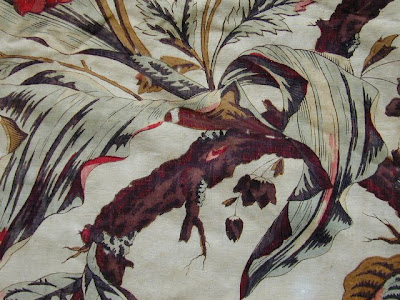I bought this unusual antique French toile from a dealer in the south central region of France a few years ago. The piece was a large quilted panel that would have hung at the head of of a bed. I first was drawn to it because of the very rarely-seen rose and yellow polychrome print. This toile is from the Alsace region, mid-19th century, and was likely designed by George Zipelius.
As I looked at the scenic motifs, I was quite amazed to realize that the story depicted French soldiers raiding a farm and stealing the farmer's goods!
Below, the first two pictures show the overall pattern and motifs. The bottom part of the first picture shows the brightness of the original colors. This bright part was near the bottom of the panel and had probably been protected from the sunlight, perhaps behind the bed.
The next four pictures are close-ups of the scenes that tell the story. The first scene shows a soldier taking wheat from the farmer's wife; the second shows a soldier wrangling a pig by grabbing its tail while his cohort helps him pull. The third scene shows one soldier enticing a chicken out of the coop while the other is preparing to whack it with a stick!
The last scene is a little difficult to interpret, but it looks like the farmer and his wife are building a masonry wall for protection, while consoling their depressed daughter. The people who lived in mid-19th century France had suffered years of war and of military confiscations, but I find it curious that they would want to hang a reminder on their wall.






















